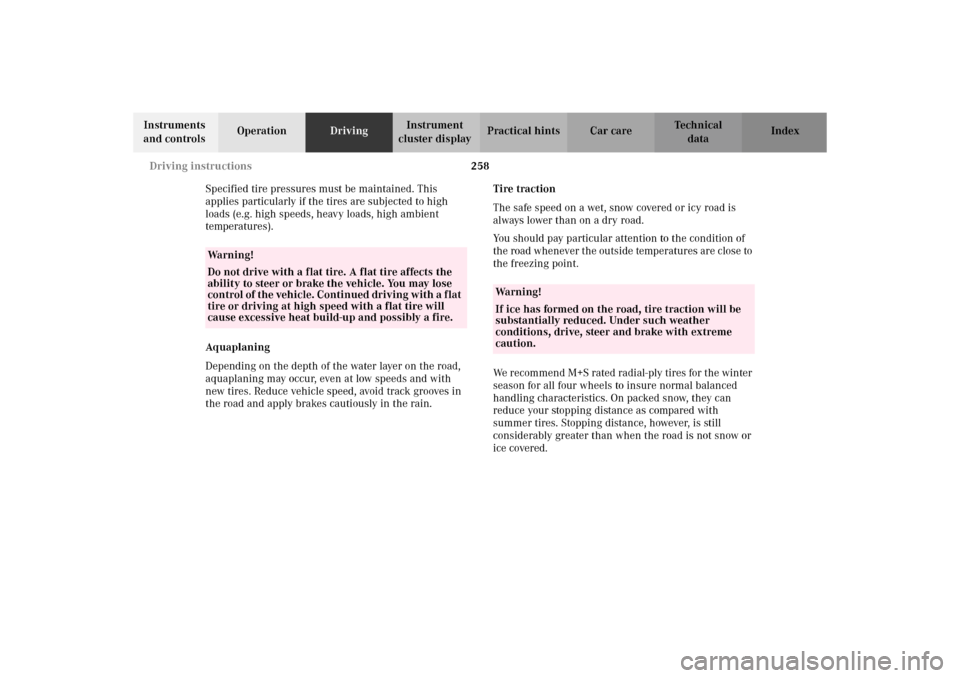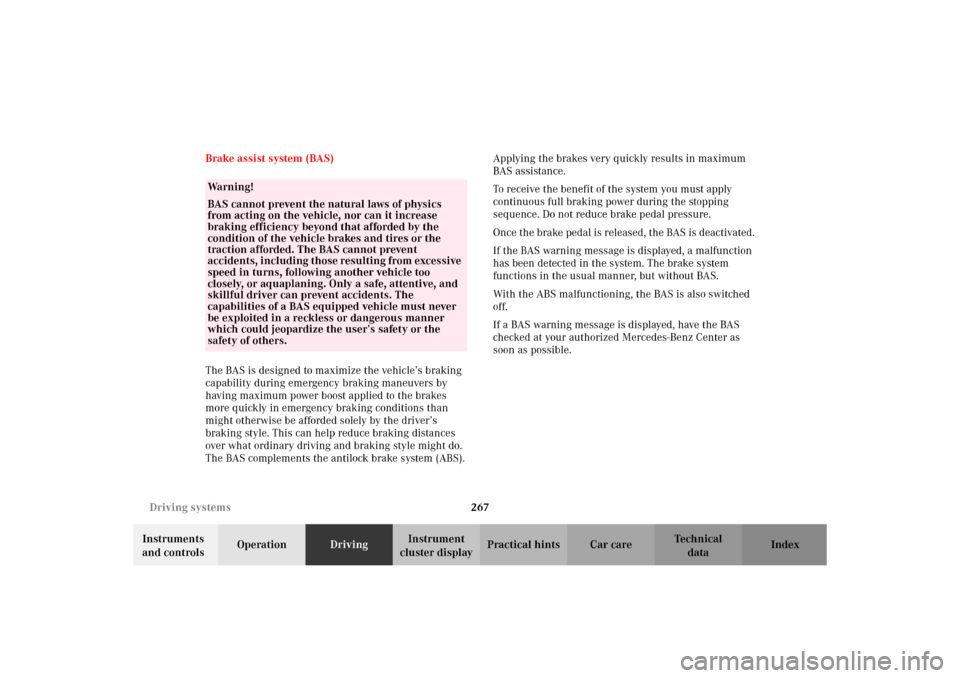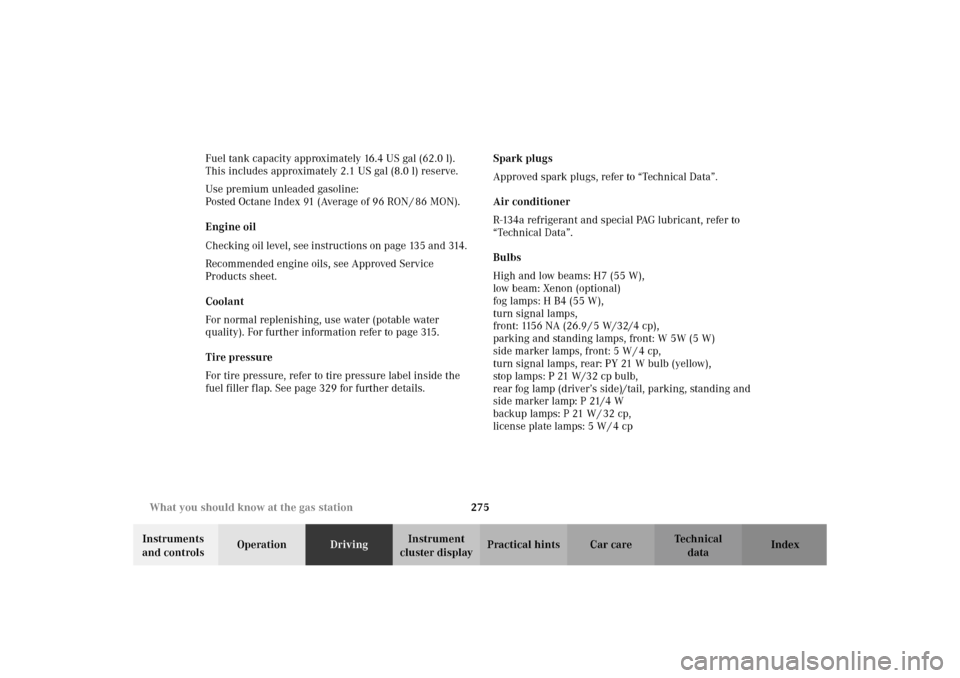2002 MERCEDES-BENZ C320 WAGON tire pressure
[x] Cancel search: tire pressurePage 8 of 390

5 ContentsELEC. STABIL. PROG.
(Electronic stability program) ..292
COOLANT
(coolant level) .............................293
COOLANT
(coolant temperature) ................294
ENGINE OIL LEVEL ...................295
STEERING GEAR OIL .................296
LIGHTING SYSTEM ....................297
LAMP SENSOR ...........................299
DOOR ............................................299
TRUNK OPEN .............................300
HOOD ...........................................300
TELEPHONE – FUNCTION ....... 301
TELE AID ..................................... 301
WASHER FLUID ..........................302
RESTRAINT SYSTEM .................303
KEY ...............................................303
FUEL RESERVE ..........................304
UNDERVOLTAGE ........................304
Practical hintsFirst aid kit ..................................... 306
Stowing things in the vehicle ...... 307
Fuses ............................................... 307
Hood ................................................. 311
Adding engine oil ........................... 314
Automatic transmission
fluid level .................................... 315
Coolant level .................................... 315
Adding coolant ............................ 316
Windshield and headlamp
washer system ........................... 316
Spare wheel,
storage compartment ................ 318
Vehicle tools .................................... 319
Vehicle jack .................................... 320
Wheels ............................................ 321
Tire replacement ....................... 321
Rotating wheels ......................... 322Spare wheel ....................................323
Spare wheel bolts .......................323
Changing wheels ...........................324
Tire inflation pressure ..................329
Battery .............................................330
Jump starting ..................................332
Towing the vehicle .........................335
Transmission selector lever,
manually unlocking ...................338
Exterior lamps ................................339
Replacing bulbs ..........................339
Standby bulb function ...................345
Changing batteries in the
electronic main key ..................346
Synchronizing
remote control ............................348
Emergency engine shut-down .....348
Fuel filler flap, manual release ...349
Replacing wiper blade insert ....... 351
Roof rack .........................................352
S203.book Seite 5 Freitag, 19. Oktober 2001 1:25 13
Page 256 of 390

253 Driving instructions
Te ch n i c a l
data Instruments
and controlsOperationDrivingInstrument
cluster displayPractical hints Car care Index Driving instructions
Drive sensibly – Save Fuel
Fuel consumption, to a great extent, depends on driving
habits and operating conditions.
To save fuel you should:
•keep tires at the recommended inflation pressures,
•remove unnecessary loads,
•remove roof rack when not in use,
•allow engine to warm up under low load use,
•avoid frequent acceleration and deceleration,
•have all maintenance work performed at regular
intervals by an authorized Mercedes-Benz Center.
Fuel consumption is also increased by driving in cold
weat her, in stop -and -go traf f ic, on short trip s an d in hilly
country.Drinking and driving
Ped al s
Wa r n i n g !
Drinking or taking drugs and driving can be a very
dangerous combination. Even a small amount of
alcohol or drugs can affect your reflexes,
perceptions and judgement.The possibility of a serious or even fatal accident is
sharply increased when you drink or take drugs
and drive.Please don’t drink or take drugs and drive or allow
anyone to drive after drinking or taking drugs.Wa r n i n g !
Keep driver’s foot area clear at all times. Objects
stored in this area may impair pedal movement.
S203.book Seite 253 Freitag, 19. Oktober 2001 1:25 13
Page 261 of 390

258 Driving instructions
Te ch n i c a l
data Instruments
and controlsOperationDrivingInstrument
cluster displayPractical hints Car care Index
Specified tire pressures must be maintained. This
applies particularly if the tires are subjected to high
loads (e.g. high speeds, heavy loads, high ambient
temperatures).
Aq uaplaning
Depending on the depth of the water layer on the road,
aquaplaning may occur, even at low speeds and with
new tires. Reduce vehicle speed, avoid track grooves in
the road and apply brakes cautiously in the rain.Tire traction
The safe speed on a wet, snow covered or icy road is
always lower than on a dry road.
You should pay particular attention to the condition of
the road whenever the outside temperatures are close to
the freezing point.
We recommend M+S rated radial-ply tires for the winter
season for all four wheels to insure normal balanced
handling characteristics. On packed snow, they can
reduce your stopping distance as compared with
summer tires. Stopping distance, however, is still
considerably greater than when the road is not snow or
ice covered.
Wa r n i n g !
Do not drive with a flat tire. A flat tire affects the
ability to steer or brake the vehicle. You may lose
control of the vehicle. Continued driving with a flat
tire or driving at high speed with a flat tire will
cause excessive heat build-up and possibly a fire.
Wa r n i n g !
If ice has formed on the road, tire traction will be
substantially reduced. Under such weather
conditions, drive, steer and brake with extreme
caution.
S203.book Seite 258 Freitag, 19. Oktober 2001 1:25 13
Page 270 of 390

267 Driving systems
Te ch n i c a l
data Instruments
and controlsOperationDrivingInstrument
cluster displayPractical hints Car care Index Brake assist system (BAS)
The BAS is designed to maximize the vehicle’s braking
capability during emergency braking maneuvers by
having maximum power boost applied to the brakes
more quickly in emergency braking conditions than
might otherwise be afforded solely by the driver’s
braking style. This can help reduce braking distances
over what ordinary driving and braking style might do.
The BAS complements the antilock brake system (ABS).Applying the brakes very quickly results in maximum
BAS assistance.
To receive the benefit of the system you must apply
continuous full braking power during the stopping
sequence. Do not reduce brake pedal pressure.
Once the brake pedal is released, the BAS is deactivated.
If the BAS warning message is displayed, a malfunction
has been detected in the system. The brake system
functions in the usual manner, but without BAS.
With the ABS malfunctioning, the BAS is also switched
off.
If a BAS warning message is displayed, have the BAS
checked at your authorized Mercedes-Benz Center as
soon as possible.
Wa r n i n g !
BAS cannot prevent the natural laws of physics
from acting on the vehicle, nor can it increase
braking efficiency beyond that afforded by the
condition of the vehicle brakes and tires or the
traction afforded. The BAS cannot prevent
ac c id ent s, i nc l udi ng t hose resul tin g from exc es si ve
speed in turns, following another vehicle too
closely, or aquaplaning. Only a safe, attentive, and
skillful driver can prevent accidents. The
capabilities of a BAS equipped vehicle must never
be exploited in a reckless or dangerous manner
which could jeopardize the user’s safety or the
safety of others.
S203.book Seite 267 Freitag, 19. Oktober 2001 1:25 13
Page 278 of 390

275 What you should know at the gas station
Te ch n i c a l
data Instruments
and controlsOperationDrivingInstrument
cluster displayPractical hints Car care Index Fuel tank capacity approximately 16.4 US gal (62.0 l).
This includes approximately 2.1 US gal (8.0 l) reserve.
Use premium unleaded gasoline:
Posted Octane Index 91 (Average of 96 RON / 86 MON).
Engine oil
Checking oil level, see instructions on page 135 and 314.
Recommended engine oils, see Approved Service
Products sheet.
Coolant
For normal replenishing, use water (potable water
quality). For further information refer to page 315.
Tire pressure
For tire pressure, refer to tire pressure label inside the
fuel filler flap. See page 329 for further details.Spark plugs
Approved spark plugs, refer to “Technical Data”.
Air conditioner
R-134a refrigerant and special PAG lubricant, refer to
“Technical Data”.
Bulbs
High and low beams: H7 (55 W),
low beam: Xenon (optional)
fog lamps: H B4 (55 W),
turn signal lamps,
front: 1156 NA (26.9 / 5 W/32/4 cp),
parking and standing lamps, front: W 5W (5 W)
side marker lamps, front: 5 W / 4 cp,
turn signal lamps, rear: PY 21 W bulb (yellow),
stop lamps: P 21 W/32 cp bulb,
rear fog lamp (driver’s side)/tail, parking, standing and
side marker lamp: P 21/4 W
backup lamps: P 21 W / 32 cp,
license plate lamps: 5 W / 4 cp
S203.book Seite 275 Freitag, 19. Oktober 2001 1:25 13
Page 308 of 390

305 Contents - Practical hints
Te ch n i c a l
data Instruments
and controlsOperation DrivingInstrument
cluster displayPractical hintsCar care Index
Practical hintsFirst aid kit .....................................306
Stowing things in the vehicle ......307
Fuses ................................................307
Hood ................................................. 311
Adding engine oil .......................... 314
Automatic transmission
fluid level ................................... 315
Coolant level ................................... 315
Adding coolant ........................... 316
Windshield and headlamp
washer system ........................... 316Spare wheel,
storage compartment ................ 318
Vehicle tools .................................... 319
Vehicle jack .................................... 320
Wheels ............................................ 321
Tire replacement ....................... 321
Rotating wheels ......................... 322
Spare wheel .................................... 323
Spare wheel bolts ...................... 323
Changing wheels ........................... 324
Tire inflation pressure ................. 329
Battery ............................................. 330
Jump starting ................................. 332Towing the vehicle .........................335
Transmission selector lever,
manually unlocking ...................338
Exterior lamps ................................339
Replacing bulbs ..........................339
Standby bulb function ...................345
Changing batteries in the
electronic main key ..................346
Synchronizing
remote control ............................348
Emergency engine shut-down .....348
Fuel filler flap, manual release ...349
Replacing wiper blade insert ....... 351
Roof rack .........................................352
S203.book Seite 305 Freitag, 19. Oktober 2001 1:25 13
Page 325 of 390

322 Tires, Wheels
Te ch n i c a l
data Instruments
and controlsOperation DrivingInstrument
cluster displayPractical hintsCar care Index
It is imperative that the wheel mounting bolts be
fastened to a tightening torque of 80 ft.lb. (110 Nm)
whenever wheels are mounted.
For rim and tire specifications, refer to “Technical Data”.Rotating wheels
The wheels can be rotated according to the degree of
tire wear while retaining the same direction of travel.
Rotating, however, should be carried out as
recommended by the tire manufacturer, before the
characteristic tire wear pattern (shoulder wear on front
wheels and tread center wear on rear wheels) becomes
visible, as otherwise the driving properties deteriorate.
Notes:
Thoroughly clean the inner side of the wheels any time
you rotate the wheels or wash the vehicle underside.
The use of retread tires is not recommended. Retread
tires may adversely affect the handling characteristics
and safety of the vehicle.
Dented or bent rims can cause tire pressure loss and
damage to the tire beads. For this reason, check rims for
damage at regular intervals. The rim flanges must be
checked for wear before a tire is mounted. Remove
burrs, if any.
Check and ensure proper tire inflation pressure after
rotating the wheels. For tire inflation pressure see
inside of fuel filler flap and also page 274.
Wa r n i n g !
Worn, old tires can cause accidents. If the tire tread
is badly worn, or if the tires have sustained
damage, replace them.When replacing rims, use only genuine
Mercedes-Benz wheel bolts specified for the
particular rim type. Failure to do so can result in
the bolts loosening and possibly an accident.
S203.book Seite 322 Freitag, 19. Oktober 2001 1:25 13
Page 332 of 390

329 Tires, Wheels
Te ch n i c a l
data Instruments
and controlsOperation DrivingInstrument
cluster displayPractical hintsCar care Index Tire inflation pressure
A table (see fuel filler flap) lists the tire inflation
pressures specified for Mercedes-Benz recommended
tires as well as for the varying operating conditions.
Important!
Tire pressure changes by approximately 1.5 psi (0.1 bar)
per 18
°F (10
°C) of air temperature change. Keep this in
mind when checking tire pressure inside a garage –
especially in the winter.
Example:
If garage temperature = approximately +68
°F (+20
°C)
and ambient temperature = approximately +32
°F (0
°C)
then the adjusted air pressure = specified air pressure
+3 psi (+0.2 bar).
Tire pressures listed for light loads are minimum values
offering high driving comfort. Increased inflation
pressures for heavy loads produce favorable handling
characteristics with lighter loads and are perfectly
permissible. The ride of the vehicle, however, will
become somewhat harder.
Tire temperature and pressure increase with the vehicle
speed. Tire pressure should therefore only be checked
and corrected on cold tires. Correct tire pressure in warm tires only if pressure has dropped below the
pressure listed in the table and the respective operating
conditions are taken into consideration.
An underinflated tire due to a slow leak (e.g. due to a
nail in the tire) may cause damage such as tread
separation, bulging etc. Regular tire pressure checks
(including the spare tire) at intervals of no more than
14 days are therefore essential.
If a tire constantly loses air, it should be inspected for
damage.
The spare tire should be checked periodically for
condition and inflation. Spare tire will age and become
worn over time even if never used, and thus should be
inspected and replaced when necessary.
Wa r n i n g !
Do not overinflate tires. Overinflating tires can
result in sudden deflation (blowout) because they
are more likely to become punctured or damaged
by road debris, potholes etc. Follow recommended
inflation pressures.Do not overload the tires by exceeding the specified
vehicle capacity weight as indicated by the label on
the driver’s door latch post). Overloading the tires
can overheat them, possibly causing a blowout.
S203.book Seite 329 Freitag, 19. Oktober 2001 1:25 13